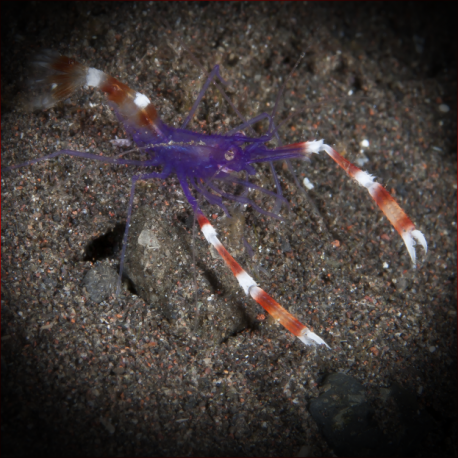More info
Datasheet
| Maximum Size | 3.8cm / 1.50inches |
| Reef Compatible | Yes |
| Temperament | Peaceful |
| Care Description | Easy |
| Specific Gravity | 1.023-1.025 |
| Carbonate Hardness | 8-12 |
| pH | 8.1-8.4 |
General Description
The Blue Banded Coral Shrimp, scientifically known as Stenopus tenuirostris, displays a vibrant blue body with striking red and sometimes white bands on its chelae and abdomen. Belonging to the Stenopodidae family, this shrimp is also referred to as the Blue Coral or Blue Boxing Shrimp. It is relatively small in size, reaching up to 3.8 cm.
Aquarium Suitability
Ideal for invertebrate and reef aquariums of various sizes, the Blue Banded Coral Shrimp serves a beneficial role by cleaning parasites and dead tissue from fish. This peaceful shrimp should be housed singularly in smaller tanks and requires careful acclimation to prevent salinity and pH shock. It is generally hardy but sensitive to high nitrates, copper levels, and inadequate iodine levels.
Care and Hardiness
Overall, the Blue Banded Coral Shrimp is considered easy to care for, provided suitable water conditions are maintained. Supplementing the tank with Calcium, Magnesium, Iodine, and Trace Elements is recommended for its well-being. Despite its hardiness, ensuring proper molting by maintaining adequate iodine levels is crucial for its health.
Reef Suitability
Rated as reef-compatible, this shrimp contributes positively to reef ecosystems by consuming bristleworms, helping control their population. It should coexist peacefully within a reef environment, benefiting from the live rock structures and diverse microorganisms present.
Aquarium Setup
When setting up an aquarium for the Blue Banded Coral Shrimp, it is essential to focus on maintaining stable water parameters. Keeping the pH between 8.1 and 8.4, alkalinity (KH) at 8-12 dKH, and salinity (SG) at 1.023-1.025 is crucial for its well-being. Incorporating hiding spots and suitable substrate for molting is recommended.
Behaviour
This peaceful shrimp species demonstrates a scavenging behavior, foraging for food among rocks and crevices in the aquarium. It helps in cleaning and maintaining the tank by actively hunting parasites and consuming dead tissue from fish, contributing to the overall cleanliness of the aquatic environment.
Feeding and Diet
In its natural habitat, the Blue Banded Coral Shrimp feeds on parasites, dead tissue, and various small organisms. In a home aquarium, it readily accepts a diet of flaked and frozen foods, plankton, and meaty items. Providing a varied diet enriched with essential nutrients ensures the shrimp remains healthy and active.
Dimorphism
While the Blue Banded Coral Shrimp does not exhibit notable dimorphism, breeding this species in captivity is challenging due to larval destruction caused by filtration and skimming. Thus, successful reproduction within an aquarium setting is rare.
Habitat and Distribution
Native to marine environments, the Blue Banded Coral Shrimp is commonly found in coral reefs across different regions. Its natural habitat includes rocky crevices and coral colonies, where it plays a vital role in maintaining the ecological balance by scavenging for food and controlling pest populations.

